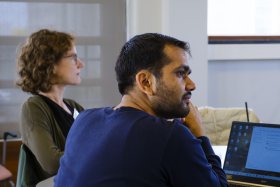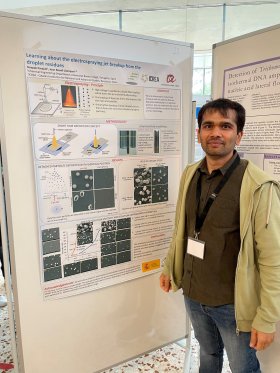Deepak Parajuli


PhD Programme: Nanoscience, Materials and Chemical Engineering
Research group: DEW – Droplets, Interfaces & Flows
Supervisor: Joan Rosell Llompart
Bio
Deepak obtained his bachelor's degree (2012) in Mechanical Engineering from the Meenakshi Academy of Higher Education and Research, India. Before his further study, he worked at Asian Paints (Nepal) Pvt. Ltd as a Mechanical Engineer. He joined the Asian Institute of Technology, Thailand under the His Majesty the King's Scholarships to pursue his master's degree (2015) in Industrial and Manufacturing Engineering. During his master thesis, he mainly focused on investigating the influence of process parameters on achieving a fine cylindrical shape fiber from the near-field electrospinning technique integrated with additive manufacturing. The developed near-field fiber deposition of electrospinning-based rapid prototyping system is able to produce straight fine fiber as well as a third dimension scaffold with controllable pattern structures. His research work was also published in a Virtual and Physical Prototyping journal. Furthermore, after completing his master's study, he worked as a teaching faculty at Nepal Engineering College, Pokhara University, Nepal. He taught the subject like Fluid Mechanics, Thermodynamics, Engineering Drawing for the undergraduate's students as well as supervised the group of student's projects related to these subjects. His research interest is the fabrication of Nanoparticles, Nanofibers, Thin coating, Biofabrication, Additive Manufacturing, etc.
Project: Electro-hydrodynamic flows for the creation of biomedical nanostructures and devices
This project lies at the interface between physics (specifically, fluid mechanics) and biomedicine (in therapeutics and diagnostics). Biomedicine demands controlling matter at scales below one micrometer, namely at the nanoscale, where small structures (for example, porous substrates) must interact with cells and other living structures. Such structures can be produced by transforming liquid shapes into solid ones. Therefore, this project will focus on fluid structures at the nanoscale and their transformation into solid structures which are useful to biomedicine. we will design and study liquid flows and complex liquids which are able to generate such structures tailored to three areas of biomedical application. One such area is the production of particles for nano biomedicine by electrospray. Similarly, another area of application is electrospinning and 3D printing to produce nanofibrous scaffolds for tissue engineering, where hierarchical control of the nanostructure at many length scales is needed. Our goal is to go much beyond standard materials as well as the conventional electrospinning technique, to create complex hierarchical structures demanded in regenerative medicine, by combining different materials and bioprinting approaches and analyzing the bioeffectiveness of the scaffolds. The third area of application is 3D printing based on electrohydrodynamic jets. Closely related to electrospinning, this is a hot area of research. Here, one aims to print nanostructures for tissue engineering applications, such as scaffolds for creating viable cellular models and tissues in vitro which can be transferred to microfluidic platforms where the response of the tissue cells can be studied in response to different chemical stimuli (e.g. drugs, pollutants, etc.). Despite the interdisciplinary nature of this project, we will mainly be focused on developing the physics and engineering aspects (fluid mechanics, complex fluids, electrohydrodynamics).
Awards & Prizes
- 2nd prize in the “Junior students” category, of the 18th Doctoral Day of the Doctoral Programme in Nanoscience, Materials and Chemical Engineering.
Outreach activities
- European Researchers' Night 2023: "H2O Heroes: Kids' Demonstration on Water Conservation, Pollution, and Treatment".



